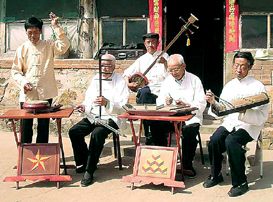 Dagu and gushu are terms that denote the same category of qu under the heading of quyi. They chiefly consist of jingyun dagu, xihe dagu, and meihua dagu .
Dagu and gushu are terms that denote the same category of qu under the heading of quyi. They chiefly consist of jingyun dagu, xihe dagu, and meihua dagu .
Jingyun dagu are stories told in Beijing dialect with a drum accompaniment.
Xihe dagu are stories told by a performer who beats a drum at the same time, with 7 or 10 words to the line.
Meihua dagu originated in Beijing and is popular in North China. In this form, the performer tells stories while beating a drum, accompanied by two or three people who play three-stringed instruments, the pipa, and the sihu .
Leting dagu, Northeast dagu, Shandong dagu, and Beijing qinshu present their narratives mainly in song form, with musical accompaniment, as do Henan zhuizi and Wenihou guci. There are dozens of such art forms. Popular in townships and rural areas as well as in cities in North China, they are performed in this way: One person beats a drum or plays clappers, accompanied by one or more musicians. The chief instrument is the sanxian or three-stringed lute, which is indispensable. There are also the sihu, pipa, and dulcimer.
The drum beaten by the storyteller is referred to as the shugu, or story telling drum, which is oblong in shape with animal skins on both ends. It is placed on a rack, which may be high or low, as required by different kinds of quyi. The drum is beaten with a bamboo stick. The clappers (ban) are of two kinds: one is made of two pieces, usually of hardwood, and the other consists of two pieces of what are called half-moon copper or steel strips, also called "mandarin duck" clappers. The script is referred to as guci and has basically seven or 10 words per line.
The story can be short, medium, or long. The short stories are in song form, without narrative. The medium and long stories require both singing and narrative, hence their performance is referred to as "singing the dagushu." The music of dagu is the banqiangti, which mainly originate from folk music in the locality where the particular type of dagu is popular. The storyteller sings in the local dialect. The difference in vocal music is the chief distinction between different kinds of dagu.
 Jingyun Dagu
Jingyun Dagu
Jingyun dagu (a kind of drumbeat performance) lays stress on singing and concentrates on depicting short episodes. It came into being and was popular in Beijing and Tianjin at the end of the Qing Dynasty and the beginning of the ROC period. Liu Baoquan initiated this particular dagu, telling stories in the Beijing dialect, replacing Hebei regional pronunciations. He absorbed the vocal music of Peking Opera and Beijing folk tunes, which he incorporated into his Jingyun dagu, using the sihu and pipa as accompaniment in addition to three-stringed lutes and wooden clappers.
